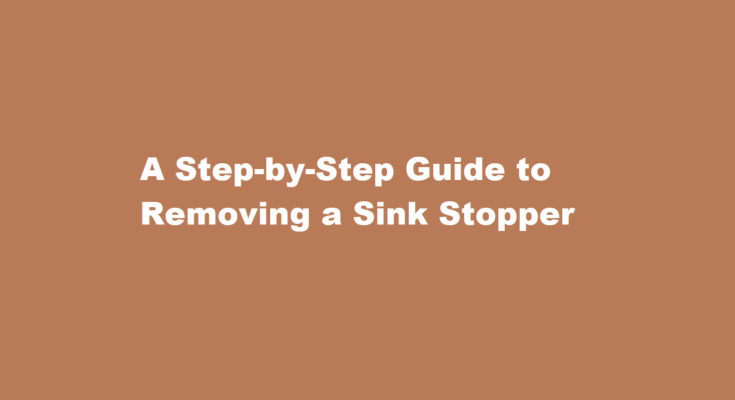Introduction
A sink stopper plays a crucial role in preventing water from draining out of the sink. However, there may come a time when you need to remove it for cleaning, repairs, or replacement. Fortunately, removing a sink stopper is a relatively simple DIY task that anyone can accomplish with the right tools and a little patience. In this article, we will walk you through the step-by-step process of removing a sink stopper, whether it’s a pop-up stopper or a different type.
Gather Your Tools
Before you begin, it’s essential to gather the necessary tools and materials. You will need
- A pair of pliers
- A bucket or towel (to catch any water)
- A screwdriver (for some stopper types)
- Gloves (optional but recommended for hygiene)
Once you have these items ready, you can proceed with the removal process.
Clear the Sink Area
Before you get started, ensure the sink is empty and free of any debris or objects. Clearing the sink area will provide you with more space to work and prevent any accidental damage to the stopper or sink itself.
Identify the Type of Stopper
Sink stoppers come in various types, including pop-up stoppers, plunger-style stoppers, and twist-and-pull stoppers. It’s crucial to identify the specific type you have, as the removal process may vary slightly depending on the design. Most common household sinks have pop-up stoppers, which we will focus on in this guide.
Remove the Pop-Up Stopper
Pop-up stoppers are prevalent in bathroom sinks. To remove one, follow these steps
- Locate the pivot rod beneath the sink. It connects the stopper to the lift rod.
- Loosen the pivot rod nut with pliers and remove it from the pivot rod.
- Pull the pivot rod out carefully, making sure not to drop any parts down the drain.
- Once the pivot rod is out, you can lift the stopper assembly from the sink.
Clean and Inspect
With the stopper removed, take the opportunity to clean it thoroughly. Over time, hair and debris can accumulate on the stopper, leading to clogs and foul odours. Inspect the stopper and pivot rod for any damage or wear, as they may need to be replaced if they are in poor condition.
Reinstallation or Replacement
After cleaning and inspecting the stopper, you can choose to reinstall it if it’s in good condition. Simply reverse the removal steps, making sure to reattach the pivot rod and tighten the pivot rod nut securely.
If the stopper is damaged or beyond repair, you can purchase a replacement at your local hardware store. Ensure that you select the correct size and type to fit your sink.
Test the Sink
After reinstallation or replacement, run water in the sink to check for leaks and ensure the stopper functions correctly. If you notice any issues, make adjustments as needed.
FREQUENTLY ASKED QUESTIONS
What are the different types of sink drain stoppers?
Bathroom sinks are the most common fixtures that use them. Sink stoppers come in a few different types, including pop-up, lift-and-turn and pull-out-plug models. Pop-ups can be operated by either pressing down on the drain cover or by lifting or pushing a rod behind the faucet.
What is a sink stopper called?
The terms “pop-up waste” and “click-clack” are commonly used to describe the two different kinds of drain plugs found at the bottom of a sink basin or tub. In general, the purpose of drain plugs is to handle clogs or blockages that would otherwise compromise the efficiency of your drainage system.
Conclusion
Removing a sink stopper may seem daunting, but with the right tools and a systematic approach, it becomes a straightforward task. Regularly cleaning and maintaining your sink stopper can help prevent clogs and prolong the life of your plumbing fixtures. By following this step-by-step guide, you can remove, clean, and even replace your sink stopper as needed, saving both time and money in the long run.
Read Also : Navigating The Mystical Paths A Guide to Reach Prifddinas



